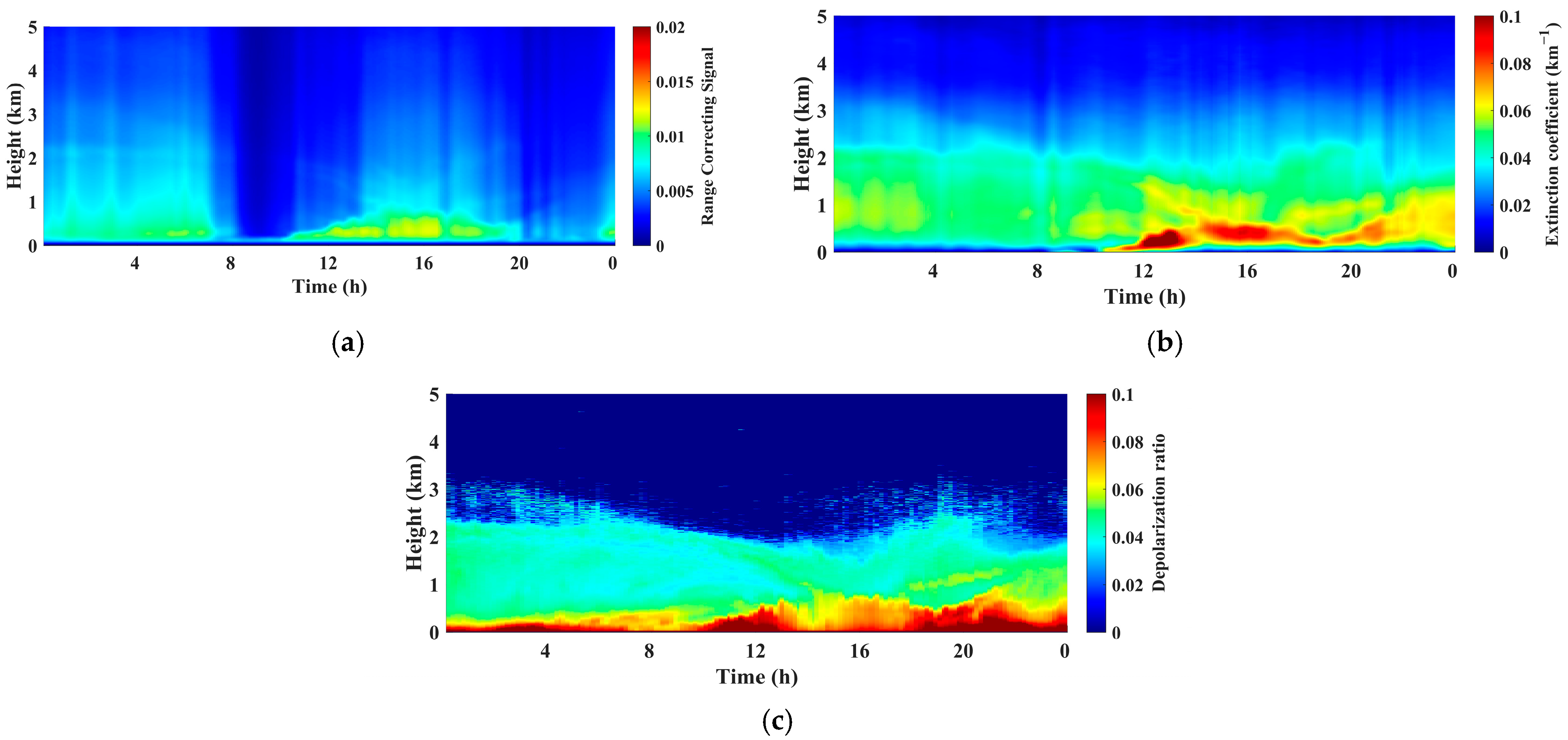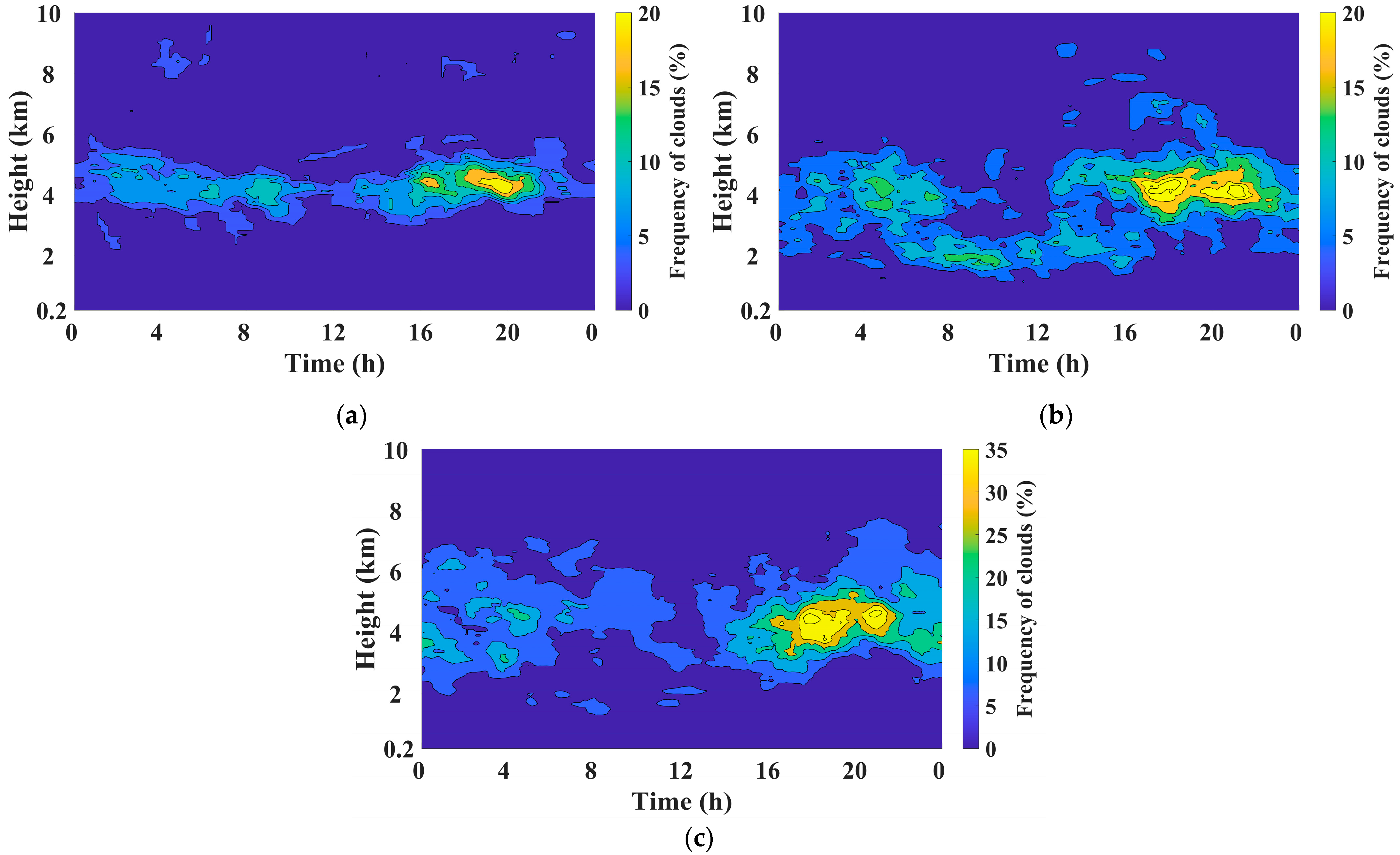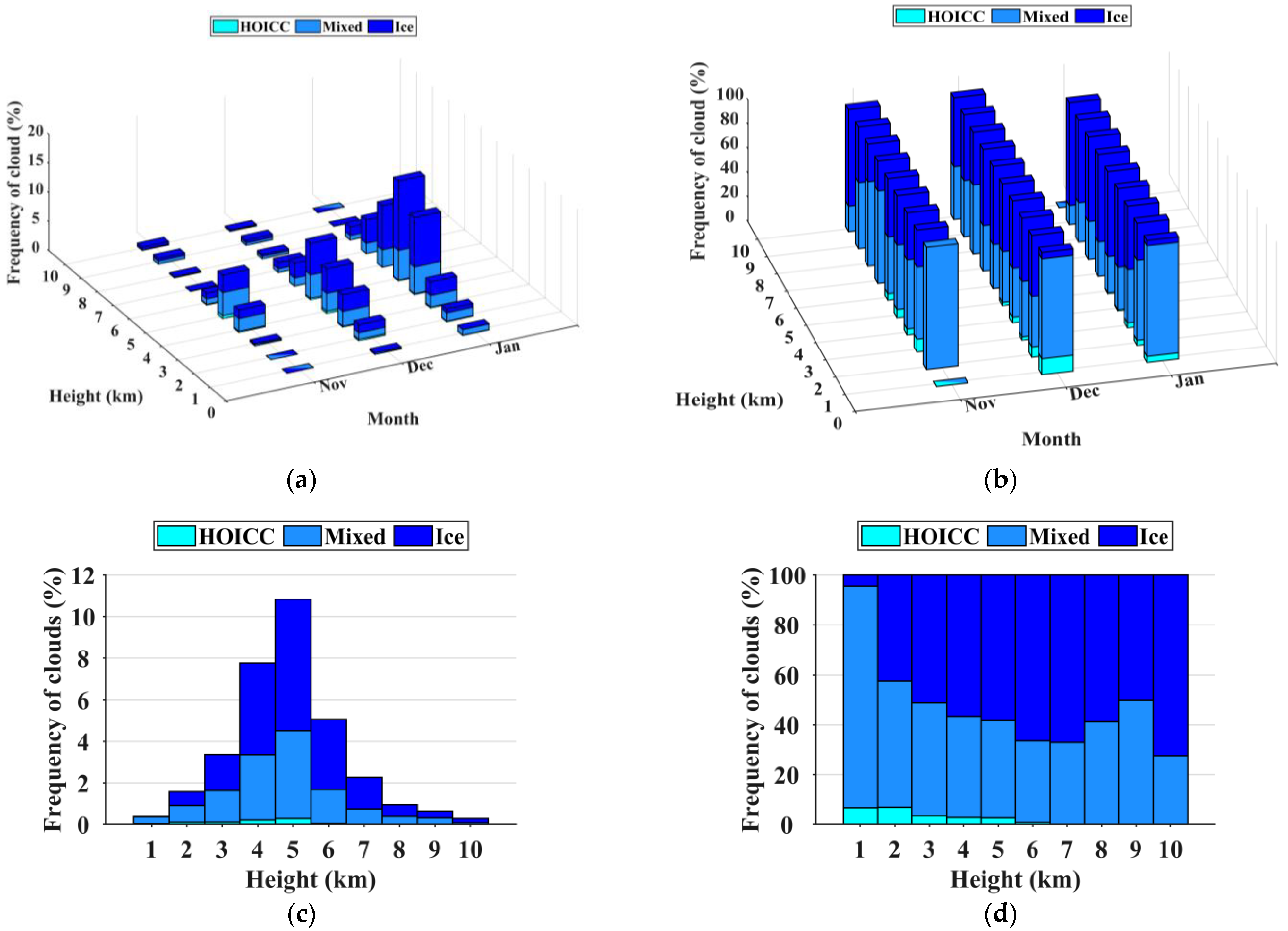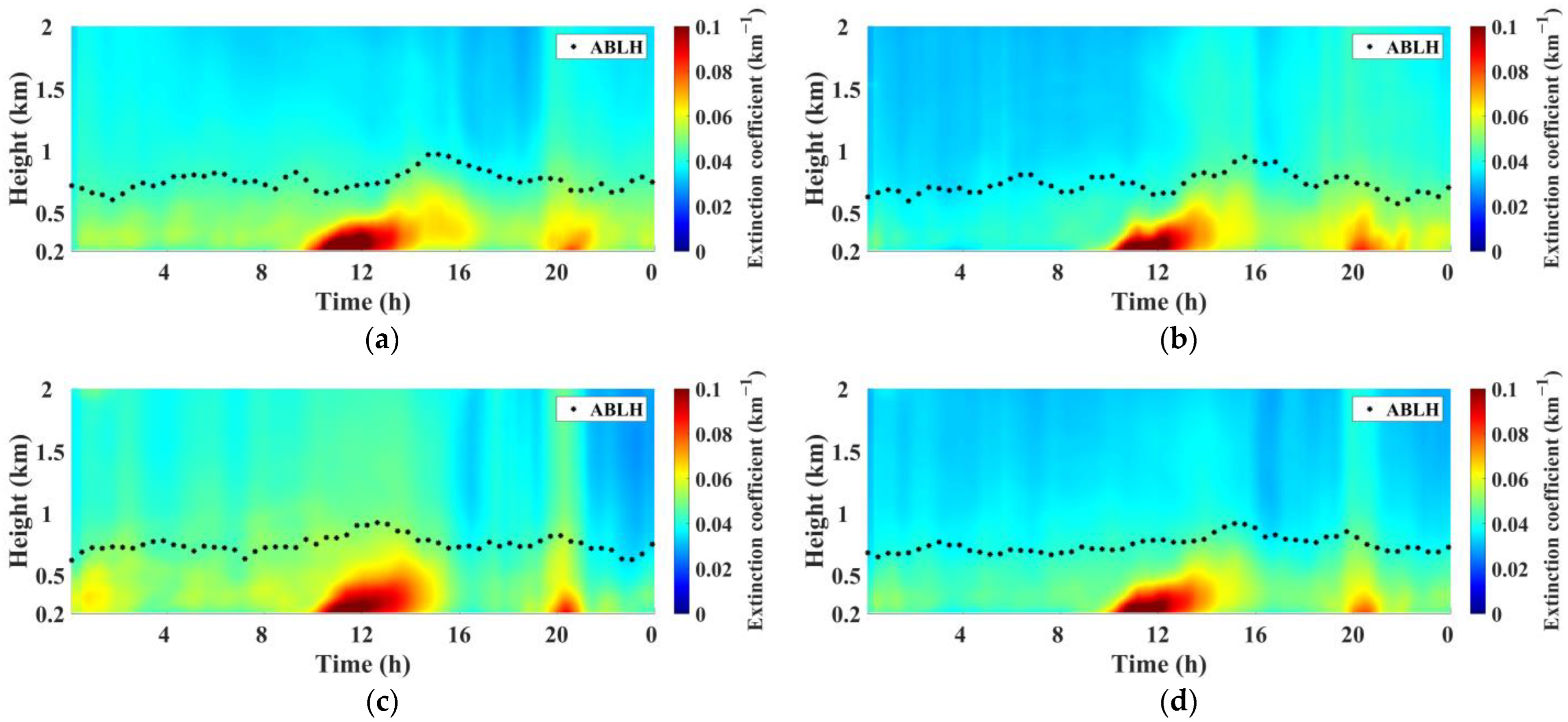Characteristics of Cloud and Aerosol Derived from Lidar Observations during Winter in Lhasa, Tibetan Plateau
Abstract
:1. Introduction
2. Materials and Methods
2.1. Site and Instrument
2.2. Retrieval of Extinction Coefficient and Depolarization Ratio
2.3. Cloud Identification and Classification
3. Results
3.1. Characteristics of Cloud Vertical Distribution
3.2. Monthly and Diurnal Variations of Vertical Distribution of Aerosol Optical Properties
4. Discussion
5. Conclusions
- Clouds always appeared except around noon during the field campaign, concentrated at a height of about 5 km. The height and frequency of cloud appearance in this study were significantly lower than that reported in summer. The cloud types are dominated by mixed clouds and ice clouds in the winter of Lhasa. The relative proportions of mixed clouds gradually decrease with increasing altitude, but the situation is opposite for ice clouds.
- The aerosol extinction coefficients decrease with increasing altitude. The depolarization ratios vary in the range of 0.06–0.1, implying that the major sources of aerosol particles did not change significantly during the observation period. There were two peaks for aerosol diurnal variation, appearing in the morning and late afternoon, respectively. The aerosols were basically distributed within the ABL. With the ABL development in the morning, the aerosol particles continued to diffuse upward for about 4 h until reaching a height of 1 km at ~15:00 BJT. For another air pollution period (around 20:00 BJT), the ABLHs were about 0.6 km and remained basically at the same level, which is not conducive to the diffusion of air pollution. In addition, the ABLH diurnal variation pattern changed slightly over the months during the field campaign.
Author Contributions
Funding
Data Availability Statement
Acknowledgments
Conflicts of Interest
Appendix A


References
- Pruppacher, H.R.; Klett, J.D. Microstructure of Atmospheric Clouds and Precipitation. In Microphysics of Clouds and Precipitation, 2nd ed.; Springer: Dordrecht, The Netherlands, 2010; Volume 18, pp. 10–73. [Google Scholar]
- Bian, Y.; Liu, L.; Zheng, J.; Wu, S.; Dai, G. Classification of Cloud Phase Using Combined Ground-Based Polarization Lidar and Millimeter Cloud Radar Observations Over the Tibetan Plateau. IEEE Trans. Geosci. Remote Sens. 2023, 61, 1–13. [Google Scholar] [CrossRef]
- Yin, Y.; Wurzler, S.; Levin, Z.; Reisin, T.G. Interactions of mineral dust particles and clouds: Effects on precipitation and cloud optical properties. J. Geophys. Res.-Atmos. 2002, 107, AAC 19-1–AAC 19-14. [Google Scholar] [CrossRef]
- Twomey, S. Aerosols, clouds and radiation. Atmos. Environ. 1991, 25, 2435–2442. [Google Scholar] [CrossRef]
- Li, M.; Cao, X.; Zhang, Z.; Ji, H.; Zhang, M.; Guo, Y.; Tian, P.; Liang, J. Optical Properties and Vertical Distribution of Aerosols Using Polarization Lidar and Sun Photometer over Lanzhou Suburb in Northwest China. Remote Sens. 2023, 15, 4927. [Google Scholar] [CrossRef]
- Xu, X.; Lu, C.; Shi, X.; Gao, S. World water tower: An atmospheric perspective. Geophys. Res. Lett. 2008, 35, L20815. [Google Scholar] [CrossRef]
- Qiu, J. China: The third pole. Nature 2008, 454, 393–396. [Google Scholar] [CrossRef] [PubMed]
- Lau, W.K.M.; Kim, M.; Kim, K.; Lee, W. Enhanced surface warming and accelerated snow melt in the Himalayas and Tibetan Plateau induced by absorbing aerosols. Environ. Res. Lett. 2010, 5, 25204. [Google Scholar] [CrossRef]
- Yu, R.; Wang, B.; Zhou, T. Climate Effects of the Deep Continental Stratus Clouds Generated by the Tibetan Plateau. J. Clim. 2004, 17, 2702–2713. [Google Scholar] [CrossRef]
- Duan, A.; Wu, G. Change of cloud amount and the climate warming on the Tibetan Plateau. Geophys. Res. Lett. 2006, 33, L22704. [Google Scholar] [CrossRef]
- Duo, B.; Cui, L.; Wang, Z.; Li, R.; Zhang, L.; Fu, H.; Chen, J.; Zhang, H.; Qiong, A. Observations of atmospheric pollutants at Lhasa during 2014–2015: Pollution status and the influence of meteorological factors. J. Environ. Sci. 2018, 63, 28–42. [Google Scholar] [CrossRef]
- Ran, L.; Lin, W.L.; Deji, Y.Z.; La, B.; Tsering, P.M.; Xu, X.B.; Wang, W. Surface gas pollutants in Lhasa, a highland city of Tibet -current levels and pollution implications. Atmos. Chem. Phys. 2014, 14, 10721–10730. [Google Scholar] [CrossRef]
- Cui, Y.Y.; Liu, S.; Bai, Z.; Bian, J.; Li, D.; Fan, K.; McKeen, S.A.; Watts, L.A.; Ciciora, S.J.; Gao, R. Religious burning as a potential major source of atmospheric fine aerosols in summertime Lhasa on the Tibetan Plateau. Atmos. Environ. 2018, 181, 186–191. [Google Scholar] [CrossRef]
- Shang, H.; Letu, H.; Nakajima, T.; Wang, Z.; Ma, R.; Wang, T.; Lei, Y.; Ji, D.; Li, S.; Shi, J. Diurnal cycle and seasonal variation of cloud cover over the Tibetan Plateau as determined from Himawari-8 new-generation geostationary satellite data. Sci. Rep. 2018, 8, 1105. [Google Scholar] [CrossRef]
- Yan, Y.; Liu, Y.; Lu, J. Cloud vertical structure, precipitation, and cloud radiative effects over Tibetan Plateau and its neighboring regions. J. Geophys. Res.-Atmos. 2016, 121, 5864–5877. [Google Scholar] [CrossRef]
- Liu, Z.; Liu, D.; Huang, J.; Vaughan, M.; Uno, I.; Sugimoto, N.; Kittaka, C.; Trepte, C.; Wang, Z.; Hostetler, C. Airborne dust distributions over the Tibetan Plateau and surrounding areas derived from the first year of CALIPSO lidar observations. Atmos. Chem. Phys. 2008, 8, 5045–5060. [Google Scholar] [CrossRef]
- Bian, Y.; Xu, W.; Hu, Y.; Tao, J.; Kuang, Y.; Zhao, C. Method to retrieve aerosol extinction profiles and aerosol scattering phase functions with a modified CCD laser atmospheric detection system. Opt. Express 2020, 28, 6631–6647. [Google Scholar] [CrossRef] [PubMed]
- Sassen, K. The Polarization Lidar Technique for Cloud Research: A Review and Current Assessment. Bull. Amer. Meteorol. Soc. 1991, 72, 1848–1866. [Google Scholar] [CrossRef]
- Bohlmann, S.; Shang, X.; Vakkari, V.; Giannakaki, E.; Leskinen, A.; Lehtinen, K.E.J.; Atsi, S.P.; Komppula, M. Lidar depolarization ratio of atmospheric pollen at multiple wavelengths. Atmos. Chem. Phys. 2021, 21, 7083–7097. [Google Scholar] [CrossRef]
- Vakkari, V.; Baars, H.; Bohlmann, S.; Uhl, J.B.; Komppula, M.; Mamouri, R.E.; O’Connor, E.J. Aerosol particle depolarization ratio at 1565nm measured with a Halo Doppler lidar. Atmos. Chem. Phys. 2021, 21, 5807–5820. [Google Scholar] [CrossRef]
- Dai, G.; Wu, S.; Song, X. Depolarization Ratio Profiles Calibration and Observations of Aerosol and Cloud in the Tibetan Plateau Based on Polarization Raman Lidar. Remote Sens. 2018, 10, 378. [Google Scholar] [CrossRef]
- Jia, R.; Liu, Y.; Chen, B.; Zhang, Z.; Huang, J. Source and transportation of summer dust over the Tibetan Plateau. Atmos. Environ. 2015, 123, 210–219. [Google Scholar] [CrossRef]
- Yin, X.; de Foy, B.; Wu, K.; Feng, C.; Kang, S.; Zhang, Q. Gaseous and particulate pollutants in Lhasa, Tibet during 2013-2017: Spatial variability, temporal variations and implications. Environ. Pollut. 2019, 253, 68–77. [Google Scholar] [CrossRef] [PubMed]
- Cheng, S.; Pu, G.; Ma, J.; Hong, H.; Du, J.; Yudron, T.; Wagner, T. Retrieval of Tropospheric NO2 Vertical Column Densities from Ground-Based MAX-DOAS Measurements in Lhasa, a City on the Tibetan Plateau. Remote Sens. 2023, 15, 4869. [Google Scholar] [CrossRef]
- Lv, L.; Liu, W.; Zhang, T.; Chen, Z.; Dong, Y.; Fan, G.; Xiang, Y.; Yao, Y.; Yang, N.; Chu, B. Observations of particle extinction, PM2.5 mass concentration profile and flux in north China based on mobile lidar technique. Atmos. Environ. 2017, 164, 360–369. [Google Scholar] [CrossRef]
- Fernald, F.G.; Herman, B.M.; Reagan, J.A. Determination of Aerosol Height Distributions by Lidar. J. Appl. Meteorol. Climatol. 1972, 11, 482–489. [Google Scholar] [CrossRef]
- Collis, R.T.H.; Russell, P.B. Lidar measurement of particles and gases by elastic backscattering and differential absorption. In Laser Monitoring of the Atmosphere; Hinkley, E.D., Ed.; Springer: Berlin, Germany, 1976; Volume 14, pp. 71–151. [Google Scholar]
- Klett, J.D. Stable analytical inversion solution for processing lidar returns. Appl. Optics 1981, 20, 211–220. [Google Scholar] [CrossRef]
- Fernald, F.G. Analysis of atmospheric lidar observations: Some comments. Appl. Optics 1984, 23, 652–653. [Google Scholar] [CrossRef] [PubMed]
- Wiegner, M.; Groß, S.; Freudenthaler, V.; Schnell, F.; Gasteiger, J. The May/June 2008 Saharan dust event over Munich: Intensive aerosol parameters from lidar measurements. J. Geophys. Res.-Atmos. 2011, 116, D23213. [Google Scholar] [CrossRef]
- Mattis, I.; Ansmann, A.; Müller, D.; Wandinger, U.; Althausen, D. Dual-wavelength Raman lidar observations of the extinction-to-backscatter ratio of Saharan dust. Geophys. Res. Lett. 2002, 29, 20–1–20–4. [Google Scholar] [CrossRef]
- National Geophysical Data Center. U.S. standard Atmosphere (1976). Planet Space Sci. 1992, 40, 553–554. [Google Scholar] [CrossRef]
- Redemann, J.; Turco, R.P.; Pueschel, R.F.; Fenn, M.A.; Browell, E.V.; Grant, W.B. A multi-instrument approach for characterizing the vertical structure of aerosol properties: Case studies in the Pacific Basin troposphere. J. Geophys. Res.-Atmos. 1998, 103, 23287–23298. [Google Scholar] [CrossRef]
- Su, J.; Liu, Z.; Wu, Y.; Mc Cormick, M.P.; Lei, L. Retrieval of multi-wavelength aerosol lidar ratio profiles using Raman scattering and Mie backscattering signals. Atmos. Environ. 2013, 79, 36–40. [Google Scholar] [CrossRef]
- Freudenthaler, V.; Esselborn, M.; Wiegner, M.; Heese, B.; Tesche, M.; Ansmann, A.; Müller, D.; Althausen, D.; Wirth, M.; Fix, A. Depolarization ratio profiling at several wavelengths in pure Saharan dust during SAMUM 2006. Tellus Ser. B-Chem. Phys. Meteorol. 2009, 61, 165–179. [Google Scholar] [CrossRef]
- Zhao, C.; Wang, Y.; Wang, Q.; Li, Z.; Wang, Z.; Liu, D. A new cloud and aerosol layer detection method based on micropulse lidar measurements. Atmos. Chem. Phys. 2014, 119, 6788–6802. [Google Scholar] [CrossRef]
- Insperger, T.; Stépán, G. Semi-discretization. In Semi-Discretization for Time-Delay Systems: Stability and Engineering Applications; Springer: New York, NY, USA, 2011; Volume 178, pp. 39–71. [Google Scholar]
- Clothiaux, E.E.; Mace, G.G.; Ackerman, T.P.; Kane, T.J.; Spinhirne, J.D.; Scott, V.S. An Automated Algorithm for Detection of Hydrometeor Returns in Micropulse Lidar Data. J. Atmos. Ocean. Technol. 1998, 15, 1035–1042. [Google Scholar] [CrossRef]
- Campbell, J.R.; Sassen, K.; Welton, E.J. Elevated Cloud and Aerosol Layer Retrievals from Micropulse Lidar Signal Profiles. J. Atmos. Ocean. Technol. 2008, 25, 685–700. [Google Scholar] [CrossRef]
- Hersbach, H.; Bell, B.; Berrisford, P.; Biavati, G.; Horányi, A.; Muñoz Sabater, J.; Nicolas, J.; Peubey, C.; Radu, R.; Rozum, I.; et al. ERA5 Hourly Data on Pressure Levels from 1940 to Present. Copernicus Climate Change Service (C3S) Climate Data Store (CDS). 2023. Available online: https://cds.climate.copernicus.eu/cdsapp#!/dataset/reanalysis-era5-pressure-levels?tab=overview (accessed on 7 January 2024).
- Noel, V.; Chepfer, H. A global view of horizontally oriented crystals in ice clouds from Cloud-Aerosol Lidar and Infrared Path finder Satellite Observation (CALIPSO). J. Geophys. Res.-Atmos. 2010, 115, D00H23. [Google Scholar] [CrossRef]
- Tao, Z.; Wang, Z.; Yang, S.; Shan, H.; Ma, X.; Zhang, H.; Zhao, S.; Liu, D.; Xie, C.; Wang, Y. Profiling the PM2.5 mass concentration vertical distribution in the boundary layer. Atmos. Meas. Tech. 2016, 9, 1369–1376. [Google Scholar] [CrossRef]
- Li, C.; Han, X.; Kang, S.; Yan, F.; Chen, P.; Hu, Z.; Yang, J.; Ciren, D.; Gao, S.; Sillanpää, M. Heavy near-surface PM2.5 pollution in Lhasa, China during a relatively static winter period. Chemosphere 2019, 214, 314–318. [Google Scholar] [CrossRef] [PubMed]
- Vivone, G.; D’Amico, G.; Summa, D.; Lolli, S.; Amodeo, A.; Bortoli, D.; Pappalardo, G. The Contribution of Local Anthropogenic Emissions to Air Pollutants in Lhasa on the Tibetan Plateau. Atmos. Chem. Phys. 2021, 21, 4249–4265. [Google Scholar] [CrossRef]
- Flamant, C.; Pelon, J.; Flamant, P.H.; Durand, P. Lidar Determination of The Entrainment Zone Thickness at the Top of the Unstable Marine Atmospheric Boundary Layer. Bound.-Layer Meteor. 1997, 83, 247–284. [Google Scholar] [CrossRef]
- Tsaknakis, G.; Papayannis, A.; Kokkalis, P.; Amiridis, V.; Kambezidis, H.D.; Mamouri, R.E.; Georgoussis, G.; Avdikos, G. Inter-comparison of lidar and ceilometer retrievals for aerosol and Planetary Boundary Layer profiling over Athens, Greece. Atmos. Meas. Tech. 2011, 4, 1261–1273. [Google Scholar] [CrossRef]
- Dang, R.; Yang, Y.; Hu, X.; Wang, Z.; Zhang, S. A Review of Techniques for Diagnosing the Atmospheric Boundary Layer Height (ABLH) Using Aerosol Lidar Data. Remote Sens. 2019, 11, 1590. [Google Scholar] [CrossRef]
- Dang, R.; Yang, Y.; Li, H.; Hu, X.; Wang, Z.; Huang, Z.; Zhou, T.; Zhang, T. Atmosphere Boundary Layer Height (ABLH) Determination under Multiple-Layer Conditions Using Micro-Pulse Lidar. Remote Sens. 2019, 11, 263. [Google Scholar] [CrossRef]
- Li, Y.; Zhang, M. Cumulus over the Tibetan Plateau in the Summer Based on CloudSat–CALIPSO Data. J. Clim. 2016, 29, 1219–1230. [Google Scholar] [CrossRef]
- Chen, S.; Wang, W.; Li, M.; Mao, J.; Ma, N.; Liu, J.; Bai, Z.; Zhou, L.; Wang, X.; Bian, J. Atmospheric boundary layer height estimation from aerosol lidar: A new approach based on morphological image processing techniques. J. Geophys. Res.-Atmos. 2022, 127, e2021JD036202. [Google Scholar] [CrossRef]







| Technical Parameters | Value |
|---|---|
| Lase type | Active Q-switched laser |
| Laser wavelength | 532.09 nm |
| Pulse energy | 0.154 mJ |
| Pulse repetition rate | 4 kHz |
| Pulse width (FWHM) | 5.945 ns |
| Laser beam divergence | x = 0.323 mrad, y = 0.329 mrad |
| Telescope type | Cassegrain |
| Telescope diameter | 150 mm |
| Vertical resolution | 7.5 m |
| Time resolution | 1 s–1800 s, adjustable |
| Effective detection range | 10 km |
| Lidar configuration type | biaxial |
| Overlap range | ≈200 m |
| Cloud Phase | T (°C) | ||
|---|---|---|---|
| water | >10−3 | >0 | ≥ 0 and ≤ 0.05 |
| mixed | >10−3 | ≤0 | > 0.05 and ≤ 0.3 |
| HOICC | >10−3 | <0 | ≥ 0 and ≤ 0.05 |
| ice | >10−3 | <0 | >0.3 |
Disclaimer/Publisher’s Note: The statements, opinions and data contained in all publications are solely those of the individual author(s) and contributor(s) and not of MDPI and/or the editor(s). MDPI and/or the editor(s) disclaim responsibility for any injury to people or property resulting from any ideas, methods, instructions or products referred to in the content. |
© 2024 by the authors. Licensee MDPI, Basel, Switzerland. This article is an open access article distributed under the terms and conditions of the Creative Commons Attribution (CC BY) license (https://creativecommons.org/licenses/by/4.0/).
Share and Cite
Jin, X.; Cheng, S.; Zheng, X.; Ma, J.; Luo, Z.; Fan, G.; Xiang, Y.; Zhang, T. Characteristics of Cloud and Aerosol Derived from Lidar Observations during Winter in Lhasa, Tibetan Plateau. Remote Sens. 2024, 16, 2074. https://doi.org/10.3390/rs16122074
Jin X, Cheng S, Zheng X, Ma J, Luo Z, Fan G, Xiang Y, Zhang T. Characteristics of Cloud and Aerosol Derived from Lidar Observations during Winter in Lhasa, Tibetan Plateau. Remote Sensing. 2024; 16(12):2074. https://doi.org/10.3390/rs16122074
Chicago/Turabian StyleJin, Xiang, Siyang Cheng, Xiangdong Zheng, Jianzhong Ma, Zangjia Luo, Guangqiang Fan, Yan Xiang, and Tianshu Zhang. 2024. "Characteristics of Cloud and Aerosol Derived from Lidar Observations during Winter in Lhasa, Tibetan Plateau" Remote Sensing 16, no. 12: 2074. https://doi.org/10.3390/rs16122074






